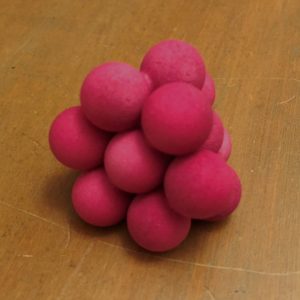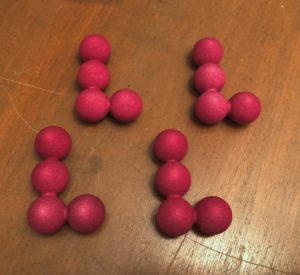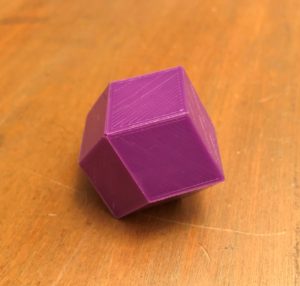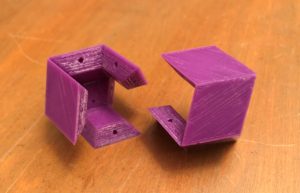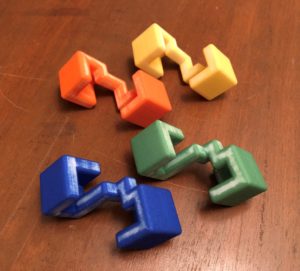I was wandering around the web recently, looking at various websites devoted to puzzle collections, puzzle designs, puzzle math, etc., and found several that were simple enough for me to fabricate myself.
The first one I’ll talk about is the “Blossom” puzzle by Bernhard Wiezorke and here’s a link to a description of it on John Rausch’s amazing website: http://www.puzzleworld.org/puzzleworld/puz/blossom.htm. As John put it, “Unbelievably, the four ‘L’ shaped pieces hold together after the last piece is snapped into place.” I was thinking of modeling an .STL file for this by hand but, not surprisingly, someone else already had: https://www.thingiverse.com/thing:1132848. I scaled it down, had it printed in sintered nylon (which gives a much better finish than my FDM printer can), and dyed it:
And here it is in its disassembled state:
They’re about the same color, size, and texture as Trix breakfast cereal (and probably as nutritious).
The second is a well-known Stewart Coffin puzzle, design #167, also known as “Cruiser”. The “Math Forum” website holds a fantastic trove of math puzzles and analyzes them in depth. Here’s their page on Coffin’s “Cruiser”. Some years ago I made some dissection puzzles with laser-cut acrylic and I thought I’d try that approach on this one. Here’s the result (shown in a semi-jumbled unsolved state):
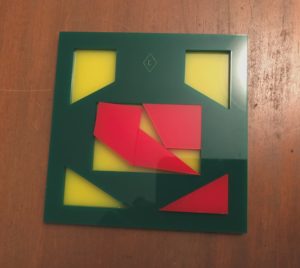
On the whole, I’m pretty happy with how it turned out although it’s smaller than I would have liked (about four inches on a side). I have inflicted it on non-puzzler friends and family and it’s a big hit – it appears simple enough to invite and then sustain prolonged effort. One of my victims called it “annoying fun”.
Third up is another Stewart Coffin design, the “Pennyhedron”, which I read about in Stewart Coffin’s 1990 book, “The Puzzling World of Polyhedral Dissections”. It’s a rhombic dodecahedron and here’s a picture of the one I made:
My initial plan was to OpenSCAD a model for the underlying rhombic shape, print twelve, and then glue / assemble them into a puzzle. Then a neuron fired inside my brain (life is full of surprises) and it said, “if you thought of it, someone else already has.” It’s not my favorite neuron but it’s right too often to ignore. Sure enough, I found this: https://www.thingiverse.com/thing:2031961. It has holes in the side for magnets which I shrank down so that I could use spare bits of printing filament to line up the edges accurately. It worked out beautifully although I did have to do some sanding on the sides to ensure their flatness. I’ve included a picture of it disassembled at the end of this post after the spoiler warning.
My fourth DIY puzzle is Dic Sonneveld’s “4 Piece Cube”. I don’t remember how I found the “Puzzle Will be Played” website but it is also an incredible goldmine of puzzles, some of which are insanely hard. Here is the link for Sonneveld’s 4 Piece Cube and here is how mine came out:
I used OpenSCAD to model the two pieces and then had Shapeways print them in sintered nylon (and I let them do the dyeing.) The assembled puzzle is about 1 1/2″ on a side. If the color pattern looks familiar, it’s because Microsoft uses it for their logo. (If you’re reading this, Microsoft, you should talk to Dic Sonneveld about making these for trade-show give-aways – they would be a huge hit!) Anyhow, I really like this puzzle because of its simple appearance and elegant design: it consists of just four pieces, two each of only two different shapes.
OK, so here’s the SPOILER ALERT. I’m about to show pictures of Coffin’s “Pennyhedron” and Sonneveld’s “4 Piece Cube” in their disassembled states, which will give away their solution. Even though the Pennyhedron is almost two decades old and is shown disassembled on John Rausch’s Pennyhedron page, I wanted to give fair warning.
When assembled the seam between the pieces is invisible and the only way to solve it is by trial and error. I think it turned out really well and if you have a 3D printer, I encourage you to give it a try.
And here is the “4 Piece Cube” puzzle disassembled:
Unfortunately, I miscalculated some of the dimensions and had to do a fair amount of sanding to get the pieces to fit; that’s why you can see the white nylon showing through the dye in several areas. But now it fits together perfectly.
That’s it for today. Puzzle on, Wayne! Puzzle on, Garth!

